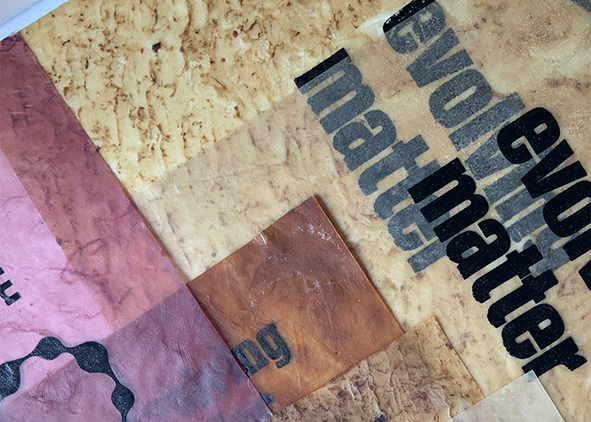Interfacce materiche. Il biologico incontra il digitale
DOI:
https://doi.org/10.19229/2464-9309/10162021Parole chiave:
materialità digitale, esperienza materiale, design delle superfici, percezione, biofabbricazioneAbstract
L’introduzione del concetto di ‘materialità digitale’ supera la consuetudine di considerare gli attributi fisici della materia in opposizione a tutto ciò che è virtuale, binario e digitale. Già Bonsiepe nel 1995 integra il carattere materico degli oggetti e il valore semiotico dell’interfaccia, riconoscendole l’abilità di configurarsi come ‘linguaggio non verbale’, ‘apparato spaziale’ che stabilisce nuove relazioni tra corpo umano e tecnologia. Le superfici dunque svolgono il ruolo chiave di ‘membrane’ che creano e ricevono stimoli innestati tra interno ed esterno, tra soggetto e oggetto. Dal quadro descritto emerge la necessità di sperimentare soluzioni alternative che rispondano alle esigenze in termini sia di circolarità/sostenibilità che di esperienza/fruizione, attraverso ad esempio interfacce materiche o sperimentazioni sui nuovi materiali biofabbricati come la nanocellulosa microbica.
Downloads
##plugins.generic.articleMetricsGraph.articlePageHeading##
Riferimenti bibliografici
Bonsiepe, G. (1995), Dall’Oggetto all’Interfaccia – Mutazione del Design, Feltrinelli, Milano.
Buci Glucksmann, C. (2004), L’art à l’époque virtuel, Collection Arts 8, L’Harmattan, Parigi.
Cytowic, R. E. (2018), Synesthesia, The MIT Press, Boston.
Dima, S., Panaitescu, D., Orban, C., Ghiurea, M., Doncea, S., Fierascu, R., Nistor, C., Alexandrescu, E., Nicolae, C., Trică, B., Moraru, A. and Oancea, F. (2017), “Bacterial Nanocellulose from Side-Streams of Kombucha Beverages Production – Preparation and Physical-Chemical Properties”, in Polymers, vol. 9, 374, pp. 1-24. [Online] Available at: doi.org/10.3390/polym9080374 [Accessed 22 September 2021].
Ferrara, M. and Lucibello, S. (2012), “Teaching material design – Research on teaching methodology about materials in industrial design”, in Strategic Design Research Journal, vol. 5, issue 2, pp. 75-83. [Online] Available at: revistas.unisinos.br/index.php/sdrj/article/view/sdrj.2012.52.03 [Accessed 29 October 2021].
Fontana, F. (2018), “L’empowerment femminile passa dai batteri – Intervista con Giulia Tommasello”, in Digicult. [Online] Available at: digicult.it/it/design/female-empowerment-goes-through-bacteria-an-interview-with-giulia-tomasello/ [Accessed 18 September 2021].
Gatenholm, P. and Klemm, D. (2010), “Bacterial Nanocellulose as a Renewable Material for Biomedical Applications”, in MRS Bulletin, vol. 35, issue 3, pp. 208-213. [Online] Available at: doi.org/10.1557/mrs2010.653 [Accessed 16 September 2021].
Gerritzen, M. and Lovink, G. (2020), Made in China, Designed in California, Criticised in Europe – Design Manifesto, BIS Publishers, Amsterdam.
Haverkamp, M. (2012), Synesthetic Design – Handbook for a multisensory approach, Birkhäuser, Basel.
Hecht, S. and Colin, K. (2003), Things That Go Unseen, Industrial Facility, London.
Jütte, R. (2004), A History of the Senses – From Antiquity to Cyberspace, Polity Press, Cambridge (UK).
Liang, H., Guan, Q., Zhu-Zhu, Song, L.-T., Yao, H., Lei, X. and Yu, S. (2012), “Highly conductive and stretchable conductors fabricated from bacterial cellulose”, in NPG Asia Materials, vol. 4, e19, pp. 1-6. [Online] Available at: doi.org/10.1038/am.2012.34 [Accessed 13 September 2021].
La Rocca, F. (2006), Il tempo opaco degli oggetti – Forme evolutive del design contemporaneo, FrancoAngeli, Milano.
Lay, M., González, I., Tarrés, J. A., Pellicer, N., Ngun Bun, K. and Vilaseca, F. (2017), “High electrical and electrochemical properties in bacterial cellulose/polypyrrole membranes”, in European Polymer Journal, vol. 91, pp. 1-9. [Online] Available at: doi.org/10.1016/j.eurpolymj.2017.03.021 [Accessed 12 September 2021].
Manovich, L. (2006), “The poetics of augmented space”, in Visual Communication, vol. 5, issue 2, pp. 219-240. [Online] Available at: doi.org/10.1177/1470357206065527 [Accessed 25 September 2021].
Manzini, E. (1986), La materia dell’invenzione – Materiali e progetto, Feltrinelli, Milano.
Tommasello, G. (2016), Bio Conductive Skin. [Online] Available at: issuu.com/giuliatomasello4/docs/bio_conductive_skin [Accessed 27 October 2021].
Zannoni, M. (2015), “Paper and Interaction – Ricerche e sperimentazioni sui nuovi oggetti cartacei interattivi”, in Acocella, A. (ed.), Paper Design, Altralinea, Firenze, pp. 42-59.

##submission.downloads##
Pubblicato
Come citare
Fascicolo
Sezione
Licenza
AGATHÓN è pubblicata sotto la licenza Creative Commons Attribution License 4.0 (CC-BY).
License scheme | Legal code
Questa licenza consente a chiunque di:
Condividere: riprodurre, distribuire, comunicare al pubblico, esporre in pubblico, rappresentare, eseguire e recitare questo materiale con qualsiasi mezzo e formato.
Modificare: remixare, trasformare il materiale e basarti su di esso per le tue opere per qualsiasi fine, anche commerciale.
Alle seguenti condizioni
Attribuzione: si deve riconoscere una menzione di paternità adeguata, fornire un link alla licenza e indicare se sono state effettuate delle modifiche; si può fare ciò in qualsiasi maniera ragionevole possibile, ma non con modalità tali da suggerire che il licenziante avalli l'utilizzatore o l'utilizzo del suo materiale.
Divieto di restrizioni aggiuntive: non si possono applicare termini legali o misure tecnologiche che impongano ad altri soggetti dei vincoli giuridici su quanto la licenza consente di fare.
Note
Non si è tenuti a rispettare i termini della licenza per quelle componenti del materiale che siano in pubblico dominio o nei casi in cui il nuovo utilizzo sia consentito da una eccezione o limitazione prevista dalla legge.
Non sono fornite garanzie. La licenza può non conferire tutte le autorizzazioni necessarie per l'utilizzo che ci si prefigge. Ad esempio, diritti di terzi come i diritti all'immagine, alla riservatezza e i diritti morali potrebbero restringere gli usi del materiale.


















































































